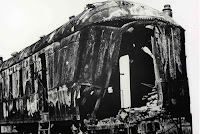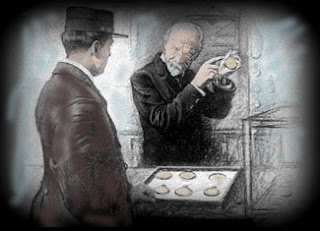by Tom Adelstein
Try to imagine the look on the Sheriff’s face when he walked from town to the remains of the train station with its telegraph lines ripped from their posts. Cars and locomotives had piled in a heap higher than the station. The wreck had twisted the rails that connected Kipton to the rest of the world.
The Sheriff saw crushed and mutilated bodies lying along the ground. Some passengers wandered about in shock. Others tried to comfort the wounded. A massive tragedy had trumped Kipton’s station.
The wreck had killed and injured dozens of people. The Sheriff recalled his father describing the sight of the killing fields at Gettysburg. The ground was red; men with arms and legs torn off moaned and corpses smoldered beyond recognition – flung about in no reasonable pattern. He didn’t have to imagine his father’s story from that night forward; such was the scene in his hamlet.
The engine of the first train, ironically nicknamed the Accommodation, had dug into the ground and laid across the track sideways. The second train’s rear rose in the air as the rest of the train smoldered on top of the other. The impact smashed the forward mail cars into kindling. A middle car snapped into the first two and rolled over the station platform.
These two trains often passed at Kipton. The Toledo Express would swing to the side track and wait for the faster mail carrier, No. 4, to speed through Kipton without slowing down. That night, the engineer pulled the Toledo Express to a stop before he saw the Fast Mail bearing down upon him. Did he wonder why the other engineer ran ahead of schedule?
The Toledo hadn’t completed its turn off the main tracks. On one side the freight cars obstructed the vision of the engineer of the Fast Mail. He attempted to break, but before he took his last breath, he knew the inevitability of the collision.
 The first thrust slammed the passengers to the floors. The second did the most damage. Most of the survivors lay in critical condition, but others could not withstand the impact and died in an instant.
The first thrust slammed the passengers to the floors. The second did the most damage. Most of the survivors lay in critical condition, but others could not withstand the impact and died in an instant.
The cause of the wreck baffled investigators. The two engineers had maneuvered Kipton a hundred times. One often mentioned he could feel the faster train approaching the station.
 One might say that unfortunate tragedies give rise to innovation. This one shocked the region. No one felt Kipton was just unfortunate. As news spread, the public wanted answers.
One might say that unfortunate tragedies give rise to innovation. This one shocked the region. No one felt Kipton was just unfortunate. As news spread, the public wanted answers.
America had the means of keeping such events from happening. The country implemented standard time in 1883. Engineers no longer set their watches to the position of the sun. Telegraphs broadcasted daily from the US Naval Observatory. Time zones became standardized beginning with Eastern time and ending with West Coast time. The country celebrated.
 The technology hadn’t stopped this wreck. It didn’t prevent investigators who entered the steamy No. 4’s engineer’s compartment from finding an upright body whose scalded and lifeless hands remained welded to the throttle.
The technology hadn’t stopped this wreck. It didn’t prevent investigators who entered the steamy No. 4’s engineer’s compartment from finding an upright body whose scalded and lifeless hands remained welded to the throttle.
The report said blackened flesh dropped from his bones when they moved him. The fireman jumped from the train and died in horrendous fashion – impaled by the ground. The postal clerks couldn’t escape; the telescoping cars crushed the life out of them without warning.
The surviving passengers of the Fast Mail No. 4 arrived in Bismarck at 10:30 PM with news of the wreck. With the telegraph down, reporters couldn’t get the news out. Some passengers could describe the wreckage, but others couldn’t speak.
The state of Ohio waited 10 years to publish the official findings. The final conclusion said that station masters flagged the Toledo Express to stop at Oberlin, but the engineer waved and continued six miles further. He didn’t have time to make a side track. Why? According to some, the engineer’s watch had stopped for four minutes. That’s speculation and it’s never been proven. The investigator found the engineer’s watch after four days, but it had ceased working at the exact time of the wreck.
The state inspector said that instead of having seven minutes to make his turn, the Toledo Express’ engineer had three. American know-how could standardize the manufacture of interchangeable watch parts. It could speed production and turn out watches by tens of thousands during what history called the second Industrial Revolution. However, American know-how couldn’t make a railroad engineer follow standard operating procedures. Two years later, a company in Lancaster Pennsylvania would provide movements on which the railroad men could rely and keep their jobs. The Kipton Wreck became a rallying call for railroads to enforce watch inspections. Hamilton built watches that met or exceeded the rules.
Copyright 2006-2017 | All Rights Reserved

